

Learning Designer. Learning Technology Support. Learning Technology plays a key role in excellent vocational teaching and learning and digital skills are an essential part of the occupational expertise required in any workplace.

Particular care has been taken to ensure these programmes are informed by the recommendations of The Further Education Learning Technology Action Group (FELTAG), our own strategic consultation on learning technology and research conducted in the sector. Our current programmes include: Staff Support Programme – Learning FuturesPROCAT Digital – A transformational project Learning Futures: A Staff Support Programme What is in the Learning Futures Programme? This digital learning technologies programme, delivered by the Gazelle Group, resulted in 17 provider-led action research projects that supported: Leaders, managers and governorsTeachers, trainers and assessment staffPartnerships between teachers / trainers and technical support teamsPartnerships between employers and vocational teachers and trainers. Lfutures. Session 2: What helps people to learn more effectively? : Jisc.
Presentation: What helps people to learn more effectively?
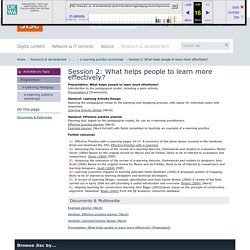
Introduction to the pedagogical model, including a pairs activity. Presentation 21 [Powerpoint] Exemplars by Focus Area. Tivity: 20 mins: How to ruin a course. Click on the image to enlarge This activity will focus on the key issues and strategies that impact on the success (or otherwise) of learning and teaching within your context.

The output of this activity will be a design checklist which you can use as one of the design evaluation tools in a mid-way design review and at the end of the workshop. 1. List the 10 best ways to ensure your module or short course will fail! 2. The 7Cs of Learning Design Toolkit. This section contains an integrated set of resources for technology-enhanced learning design across discplines.

The resources have all been tried and tested by participants on the University of Leicester's Carpe Diem workshops and the Open University's OULDI (OU Learning Design Initiative) project, and are organised under the headings of seven Cs: conceptualise, capture, create, communicate, collaborate, consider and consolidate. Sesssion2. A place to explore new ideas in Learning. 16 Things I Love About the 2016 National Education Technology Plan. The DOE’s Office of Education Technology recently published the 2016 National Education Technology Plan.
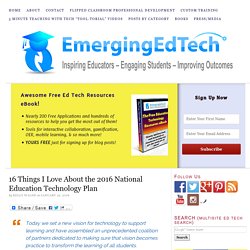
The plan is titled, “Future Ready Learning. Reimagining the Role of Technology in Education”. While “love” is not a word many of us in the world of education may often use when referring the work of the U.S. Department of Education, the fact is, there is a lot I really feel strongly about in this plan. The Office of Education Technology has done good work here, and this plan hits on many of the important ideas that I believe many will agree should be a priority (of course, some feedback from detractors is also expected – but that’s all good too!). About UDL. A short video by CAST illustrates the three principles of Universal Design for Learning.
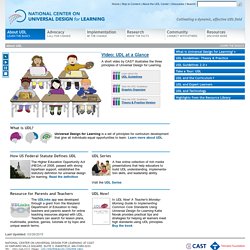
How US Federal Statute Defines UDL The Higher Education Opportunity Act (HEOA) of 2008, passed with strong bipartisan support, established the statutory definition for universal design for learning. Read the definition. The International Association for Distance Learning. The Basics of eLearning eLearning is about getting the right information to people at the right time.
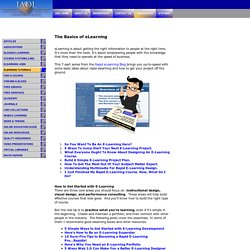
It’s more than the tools. Christopher Pappas on how to become an Instructional Designer. By Christopher Pappas You want to pursue a career in Instructional Design but you don’t know how to start?
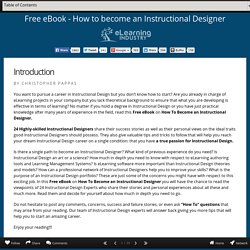
Are you already in charge of eLearning projects in your company but you lack theoretical background to ensure that what you are developing is effective in terms of learning? No matter if you hold a degree in Instructional Design or you have just practical knowledge after many years of experience in the field, read this Free eBook on How To Become an Instructional Designer. 24 Highly-skilled Instructional Designers share their success stories as well as their personal views on the ideal traits good Instructional Designers should possess. Learning Technology Support. Instructional Design - Learning futures. CPDModuleActivitySheetInstructionalDesign. Game Changers in Online Learning: Series. Online learning is coming of age.

From the early steps in 1993-1995, to major developments around the world – Massive Open Online Courses (MOOCs), multimedia customized text books, badges to accredit learning, on-demand online learning for credit, learning analytics – all are attracting a great deal of attention. Online learning can now be seen as an accepted part of the post-secondary education systems in many jurisdictions around the world. Ontario leads Canada in the provision of over 1,000 distance and online programs, over 18,000 distance and online courses, and over 500,000 registrations in online courses. Big Dog and Little Dog's Performance Juxtaposition.
Why Online Courses [Really] Need an Instructional Design Strategy. In this post I examine and define instructional design, and share why it’s essential to the development of online courses.
![Why Online Courses [Really] Need an Instructional Design Strategy](http://cdn.pearltrees.com/s/pic/th/courses-instructional-strategy-107003880)
“Design brings forth what would not come naturally“ Klaus Krippendorff Developing an online course that is engaging, promotes interaction, motivates learners, and above all facilitates learning is easier said than done. It’s even more challenging when trying to modify a face-to-face course for the online format. E-tivities: Amazon.co.uk: Gilly Salmon: 9780415881760: Books. Review “At a time when higher education is struggling to take advantage of the many technological innovations available to it, this timely and thought-provoking second edition of E-tivities envisions a new way to deliver curriculum. The book is written in a user friendly and accessible style, challenging thinking not to merely shift from ‘traditional’ teaching to technologically supported learning, but to re-think the learning process and conceptualise content and delivery differently, in an e-form.
Making a sound conceptual argument, the author makes exceptional use of case studies and guided thinking for the development of e-tivities, including the use of open educational resources. This is a must read not only for the practitioner wanting to change, but for institutional leaders as well.” ―Craig Mahoney, Chief Executive, Higher Education Academy, UK. Rethinking Pedagogy for a Digital Age: Designing for 21st Century Learning: Amazon.co.uk: Helen Beetham, Rhona Sharpe: 9780415539975: Books. Teaching as a Design Science: Amazon.co.uk: Diana Laurillard: Books.
Review All the national and international accolades that appear in the book and on the back cover of Teaching as a Design Science are justly deserved; this is an innovative endeavor by a visionary author, Diana Laurillard. This text is rich in research studies and the use of digital technologies to enhance learning. " ―Teachers College Record "The book is written for teachers at all levels, although it will probably be of primary interest to higher education faculty who have the time and resources to explore the ideas presented.
A new curriculumn for difficult times. Leading%20wholescale%20curriculum%20redesign. Homepage. Managingcurriculumchange. FE29 7 Strategic SERCv2 FINAL. The Four-door Model: Rapid eLearning Design. SumoMe In this interview, I discuss the Four-door Design Model with Russ Powell, who worked with its creator, Dr. Sivasailam Thiagarajan, a.k.a. Thiagi, several years ago. This is a two-part interview. COACH: Before we get into the Four-door Model, can you give me a little background on its origination? RUSS: I worked closely with Thiagi several years ago and during that time I picked up a saying of his that goes something like this, “In any given instructional project the person who learns the most is not the student, but the instructional designer. COACH: What is the Four-door Model?
Five Stage Model - Gilly Salmon. Deliver a relevant digital curriculum. “Staff and students have different digital literacy skills sets. Combining the digital bravery (R Sharpe and G Benfield) of the students with staff knowledge and expertise of a given domain can allow you to critically investigate digital practice in a subject.”Jim Pettiward, blended learning facilitator, Centre for the Enhancement of Learning and Teaching (CELT), London Metropolitan University Fulfil student expectations The pervasive use of technology in so many aspects of our lives means that students will come to further or higher education with some experience of technology and the expectation that it will feature in their learning journey.
They will expect digital services like wifi to be freely and easily accessible as a core entitlement and that efficient administration processes and wrap around services will support their overall experience. Tooc15: Learning design frameworks and tools: Resources. The title of this week is 'Designing engaging online activities’, but we actually need to start a step back from that, with a question: how can we articulate and explain our learning designs so that we can share them with other people? (There are lots of reasons we might want to do this, for example for the purposes of support and critique, or for sharing your work so that others can benefit from it, or simply for your own records.)So we start off with some models of learning design.
There are lots of them, some aiming to define existing activities, and others to help you create new ones. You’ll probably find that some work better for you and/or your context than others. Watch this short video by our colleague Dr. What is instructional design and technology? Making the Digital Connections to Improve Education in the 21st Century
Teaching and Learning Resources / Instructional Approaches. 5 Instructional Design Tips To Enhance Metacognition In eLearning. An empowered learner is a successful learner. Not only do they have the confidence they need to solve problems autonomously, but they are active participants who are motivated and inspired to learn. Getting To Know ADDIE: Part 2 - Design. In the previous installment we took our first look at the ADDIE model. We learned its general characteristics, considered its advantages and disadvantages, and also discussed at length the first stage of the ADDIE methodology - Analysis. Getting To Know ADDIE: Part 1 – Analysis. Although there are many different models and methodologies for the creation of training materials in the eLearning world, the ADDIE model is, undoubtedly, the most popular of all.
If you are a veteran, you certainly know what ADDIE is and how to create in line with that model, and I doubt I will be able to tell you anything you do not already know. However, if you are new to the industry, or simply have not heard the name before, this article will get you up to speed, introducing you to the methodology and showing you how it can help you.
In a nutshell, ADDIE is an acronym where every letter corresponds to one of the model’s main phases: Analysis, Design, Development, Implementation, and Evaluation. To learn. To inspire. To share. Gamification Of Learning Design: How To Use Learning Battle Cards? About 4 weeks ago I wrote an article about a new tool called Learning Battle Cards. Is Design Thinking Missing From ADDIE? SumoMe Even though a crucial part of our jobs involve design, the prevailing instructional design models are based on systems thinking. Systems thinking promotes an analytical or engineering type of mindset. Material Results. The Design Studio / Welcome to the Design Studio. Using technology to improve curriculum design. Introduction The process of curriculum design combines educational design with many other areas including: information management, market research, marketing, quality enhancement, quality assurance and programme and course approval.
Open University Learning Design Initiative. CompendiumLD learning design software. A Periodic Table of Instructional Design.